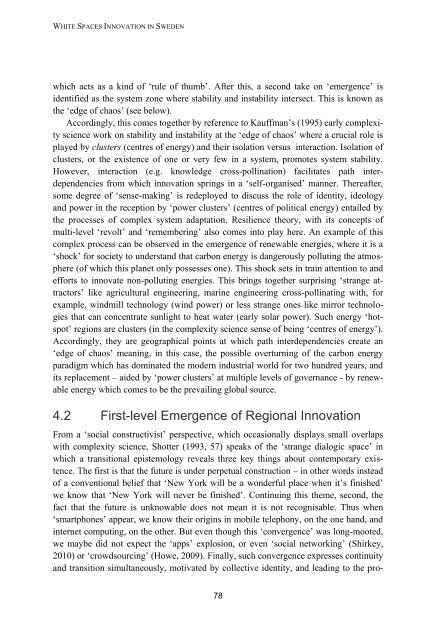White Spaces Innovation in Sweden - Innovation policy for ... - Vinnova
White Spaces Innovation in Sweden - Innovation policy for ... - Vinnova
White Spaces Innovation in Sweden - Innovation policy for ... - Vinnova
You also want an ePaper? Increase the reach of your titles
YUMPU automatically turns print PDFs into web optimized ePapers that Google loves.
WHITE SPACES INNOVATION IN SWEDENwhich acts as a k<strong>in</strong>d of „rule of thumb‟. After this, a second take on „emergence‟ isidentified as the system zone where stability and <strong>in</strong>stability <strong>in</strong>tersect. This is known asthe „edge of chaos‟ (see below).Accord<strong>in</strong>gly, this comes together by reference to Kauffman‟s (1995) early complexityscience work on stability and <strong>in</strong>stability at the „edge of chaos‟ where a crucial role isplayed by clusters (centres of energy) and their isolation versus <strong>in</strong>teraction. Isolation ofclusters, or the existence of one or very few <strong>in</strong> a system, promotes system stability.However, <strong>in</strong>teraction (e.g. knowledge cross-poll<strong>in</strong>ation) facilitates path <strong>in</strong>terdependenciesfrom which <strong>in</strong>novation spr<strong>in</strong>gs <strong>in</strong> a „self-organised‟ manner. Thereafter,some degree of „sense-mak<strong>in</strong>g‟ is redeployed to discuss the role of identity, ideologyand power <strong>in</strong> the reception by „power clusters‟ (centres of political energy) entailed bythe processes of complex system adaptation. Resilience theory, with its concepts ofmulti-level „revolt‟ and „remember<strong>in</strong>g‟ also comes <strong>in</strong>to play here. An example of thiscomplex process can be observed <strong>in</strong> the emergence of renewable energies, where it is a„shock‟ <strong>for</strong> society to understand that carbon energy is dangerously pollut<strong>in</strong>g the atmosphere(of which this planet only possesses one). This shock sets <strong>in</strong> tra<strong>in</strong> attention to andef<strong>for</strong>ts to <strong>in</strong>novate non-pollut<strong>in</strong>g energies. This br<strong>in</strong>gs together surpris<strong>in</strong>g „strange attractors‟like agricultural eng<strong>in</strong>eer<strong>in</strong>g, mar<strong>in</strong>e eng<strong>in</strong>eer<strong>in</strong>g cross-poll<strong>in</strong>at<strong>in</strong>g with, <strong>for</strong>example, w<strong>in</strong>dmill technology (w<strong>in</strong>d power) or less strange ones like mirror technologiesthat can concentrate sunlight to heat water (early solar power). Such energy „hotspot‟regions are clusters (<strong>in</strong> the complexity science sense of be<strong>in</strong>g „centres of energy‟).Accord<strong>in</strong>gly, they are geographical po<strong>in</strong>ts at which path <strong>in</strong>terdependencies create an„edge of chaos‟ mean<strong>in</strong>g, <strong>in</strong> this case, the possible overturn<strong>in</strong>g of the carbon energyparadigm which has dom<strong>in</strong>ated the modern <strong>in</strong>dustrial world <strong>for</strong> two hundred years, andits replacement – aided by „power clusters‟ at multiple levels of governance - by renewableenergy which comes to be the prevail<strong>in</strong>g global source.4.2 First-level Emergence of Regional <strong>Innovation</strong>From a „social constructivist‟ perspective, which occasionally displays small overlapswith complexity science, Shotter (1993, 57) speaks of the „strange dialogic space‟ <strong>in</strong>which a transitional epistemology reveals three key th<strong>in</strong>gs about contemporary existence.The first is that the future is under perpetual construction – <strong>in</strong> other words <strong>in</strong>steadof a conventional belief that „New York will be a wonderful place when it‟s f<strong>in</strong>ished‟we know that „New York will never be f<strong>in</strong>ished‟. Cont<strong>in</strong>u<strong>in</strong>g this theme, second, thefact that the future is unknowable does not mean it is not recognisable. Thus when„smartphones‟ appear, we know their orig<strong>in</strong>s <strong>in</strong> mobile telephony, on the one hand, and<strong>in</strong>ternet comput<strong>in</strong>g, on the other. But even though this „convergence‟ was long-mooted,we maybe did not expect the „apps‟ explosion, or even „social network<strong>in</strong>g‟ (Shirkey,2010) or „crowdsourc<strong>in</strong>g‟ (Howe, 2009). F<strong>in</strong>ally, such convergence expresses cont<strong>in</strong>uityand transition simultaneously, motivated by collective identity, and lead<strong>in</strong>g to the pro-78
















